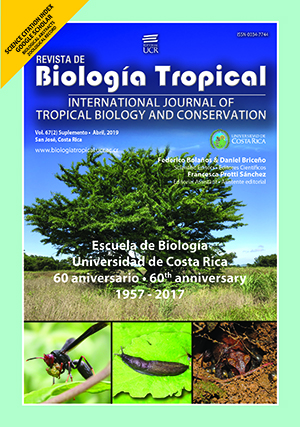Abstract
The study of phenological patterns in plant communities is of vital importance for understanding the temporal cycles of ecosystems, but there is little information on the diversity of phenological patterns that can occur at the intraspecific level, as well as the genetic or environmental factors causing this variation. In Handroanthus ochraceus, a deciduous tree species of neotropical dry forests, ecophysiological studies have proposed the release of water stress as the mechanism that triggers flowering and the sprouting of new leaves. During four years, I observed the cycles of leaf fall, flowering, fruiting, and new leaf production in seven Costa Rican sites that differed in their proximity to water courses and in soil moisture. Six were located in dry forest areas, and one in premontane forest. There were two general phenological patterns: the explosive, where trees depend on the first rains for floral anthesis and the expansion of leaf meristems, and the staggered pattern, with unsynchronized flowering at the beginning and middle of the dry season, independently of rainfall. Although this phenological variation has been previously recognized, the occurrence of these two patterns is not determined by the proximity of water courses, contradicting phenological models proposed for this tree species.
References
Ashton, P. S., Givnish, T. J., & Appanah, S. (1988). Staggered flowering in the Dipterocarpaceae: new insights into floral induction and the evolution of mast fruiting in the aseasonal tropics. The American Naturalist, 132, 44-66.
Barros, M. G. (2001). Pollination ecology of Tabebuia aurea (Manso) Benth. & Hook. and T. ochracea (Cham.) Standl. (Bignoniaceae) in Central Brazil cerrado vegetation. Brazilian Journal of Botany, 24, 255-261.
Borchert, R. (1994a). Induction of rehydration and bud break by irrigation or rain in decidous trees of a tropical dry forest in Costa Rica. Trees-Structure and Function, 8, 198-204.
Borchert, R. (1994b). Soil and stem water storage determine phenology and distribution of tropical dry forest trees. Ecology, 75, 1437-1449.
Borchert, R., Meyer, S. A., Felger, R. S., & Porter-Bolland, L. (2004). Environmental control of flowering periodicity in Costa Rican and Mexican tropical dry forests. Global Ecology and Biogeography, 13, 409-425.
Dahlgren, J. P., von Zeipel, H., & Ehrlén, J. (2007). Variation in vegetative and flowering phenology in a forest herb caused by environmental heterogeneity. American Journal of Botany, 94, 1570-1576.
Frankie, G. W., Baker, H. G., & Opler, P. A. (1974). Comparative phenological studies of trees in tropical wet and dry forests in the lowlands of Costa Rica. Journal of Ecology, 62, 881-919.
Fournier, L. A. (1974). Método cuantitativo para la medición de características fenológicas en árboles. Turrialba, 24, 422-423.
Fuchs, E. J., Lobo, J. A., & Quesada, M. (2003). Effects of forest fragmentation and flowering phenology on the reproductive success and mating patterns of the tropical dry forest tree Pachira quinata. Conservation Biology, 17, 149-157.
Gentry, A. H. (1970). A revision of Tabebuia (Bignoniaceae) in Central America. Brittonia, 22, 246-264.
Gentry, A. H. (1974). Flowering phenology and diversity in tropical Bignoniaceae. Biotropica, 6, 64-68.
Gentry, A. H. (1992). Bignoniaceae: Part II (Tribe Tecomeae). Flora Neotropica, 25, 1-370.
Grose, S. O., & Olmstead, R. G. (2007). Taxonomic revisions in the polyphyletic genus Tabebuia s.l. (Bignoniaceae). Systematic Botany, 32, 660-670.
Herrerías-Diego, Y., Quesada, M., Stoner, K. E., & Lobo, J. A. (2006). Effects of forest fragmentation on phenological patterns and reproductive success of the tropical dry forest tree Ceiba aesculifolia. Conservation Biology, 20, 1111-1120.
Holdridge, L. R., & Tosi, J. A. (1967). The life zone. Life Zone Ecology. San José, Costa Rica: Tropical Science Center.
Instituto Meterológico Nacional (IMN). (2015). Boletín del ENOS No. 79 (Informe 14). San José, Costa Rica. Recuperado de https://www.imn.ac.cr/documents/10179/28160/%23%2079
Neil, K., & Wu, J. (2006). Effects of urbanization on plant flowering phenology: a review. Urban Ecosystems, 9, 243-257.
Opler, P. A., Frankie, G. W., & Baker, H. G. (1976). Rainfall as a factor in the release, timing, and synchronization of anthesis by tropical trees and shrubs. Journal of Biogeography, 3, 231-236.
Reich, P. B., & Borchert, R. (1982). Phenology and ecophysiology of the tropical tree, Tabebuia neochrysantha (Bignoniaceae). Ecology, 63, 294-299.
Reich, P. B., & Borchert, R. (1984). Water stress and tree phenology in a tropical dry forest in the lowlands of Costa Rica. Journal of Ecology, 72, 61-74.
Rivera, G., Elliott, S., Caldas, L. S., Nicolossi, G., Coradin, V. T., & Borchert, R. (2002). Increasing day-length induces spring flushing of tropical dry forest trees in the absence of rain. Trees-Structure and Function, 16, 445-456.
Sakai, S., Momose, K., Yumoto, T., Nagamitsu, T., Nagamasu, H., Hamid, A. A., & Nakashizuka, T. (1999). Plant reproductive phenology over four years including an episode of general flowering in a lowland dipterocarp forest, Sarawak, Malaysia. American Journal of Botany, 86, 1414-1436.
SanMartin-Gajardo, I., & Morellato, P. C. (2003). Inter and intraspecific variation on reproductive phenology of the Brazilian Atlantic forest Rubiaceae: ecology and phylogenetic constraints. Revista de Biología Tropical, 51, 691-698.
Wright, S. J., & Van Schaik, C. P. (1994). Light and the phenology of tropical trees. The American Naturalist, 143, 192-199.
Wright, S. J., & Calderón, O. (2006). Seasonal, El Nino and longer term changes in flower and seed production in a moist tropical forest. Ecology letters, 9, 35-44.
##plugins.facebook.comentarios##

This work is licensed under a Creative Commons Attribution 4.0 International License.
Copyright (c) 2019 Revista de Biología Tropical


